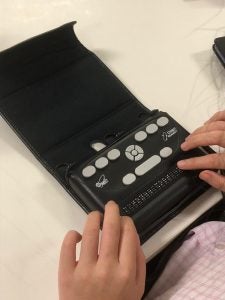
Learning more about the Deafblind community
15 Oct 2019
Event Navigation

Article written by Chia Qi En, Joy
The Hidden Communities in Singapore module invited three Deafblind speakers to class on 15 Oct 2019. The speakers shared their lived experiences and some of the challenges of the Deafblind community. One common perception is that the Deafblind are completely blind and deaf, and have no ability to communicate with others. However, I learnt that that is not true. Differing spectrums of blindness and hearing loss among Deafblind individuals enable them to adopt different means of communication. Most Deaf-oriented Deafblind individuals use tactile sign language, where they place their hands over the hands of the interpreter, feeling and following the signs of the interpreter. They communicate with others through the use of sign language. Blind-oriented Deafblind, on the other hand, rely on braille and speech to communicate. The Blind-oriented speaker used braille assistive technology, whereby a notetaker (someone who is professionally employed to assist in conveying messages) typed information into an app on her phone, which then relays that message through a refreshable Braille display that displays what has been typed in braille.
 I was amazed at how the Deafblind have their own modes of communication, that differ between the Deaf-oriented and Blind-oriented. However, these forms of communication are only known to and used by the Deafblind community, interpreters and notetakers. Significant communication barriers are still present between the Deafblind individuals and the hearing and sighted community as a result of the lack of awareness to these means of communication. Awareness of the Deafblind community and the challenges they face are important for the public’s knowledge so as to create an inclusive environment for the all to access information and communicate with others.
I was amazed at how the Deafblind have their own modes of communication, that differ between the Deaf-oriented and Blind-oriented. However, these forms of communication are only known to and used by the Deafblind community, interpreters and notetakers. Significant communication barriers are still present between the Deafblind individuals and the hearing and sighted community as a result of the lack of awareness to these means of communication. Awareness of the Deafblind community and the challenges they face are important for the public’s knowledge so as to create an inclusive environment for the all to access information and communicate with others.
The speakers brought up two different models in which disability is viewed – the charity model and the social model. The charity model views disabilities as unfortunate events and that society should find ways to help the disabled. It focuses on what is ‘wrong’ with the disabled, and how they can be ‘cured’ and helped by the non-disabled. On the other hand, the social model suggests that disability is caused by the way society is run, rather than the individual’s medical condition. It focuses on removing barriers in society and the physical environment so that the disabled can be independent and equal in society. The latter model provides a much more inclusive and accessible environment for the Deafblind. In the future, be it in our daily routine of life or when we step out to work, let us be mindful and sensitive to the systems and practices in place that inadvertently discriminate against certain communities.
